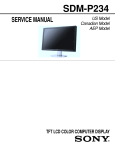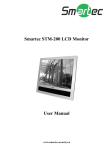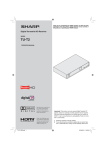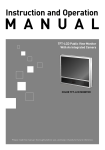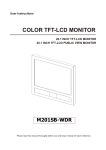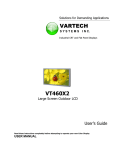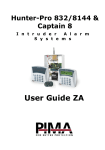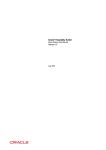Download M261WLC-WDR-W
Transcript
Instruction and Operation M A N U A L TFT-LCD MONITOR TFT-LCD PUBLIC VIEW MONITOR COLOR TFT-LCD MONITOR Please read this manual thoroughly before use, and keep it handy for future reference. LIMITATION OF LIABILITY THE INFORMATION IN THIS PUBLICATION IS BELIEVED TO BE ACCURATE IN ALL RESPECTS, HOWEVER, WE CANNOT ASSUME RESPONSIBILITY FOR ANY CONSEQUENCES RESULTING FROM THE USE THEREOF. THE INFORMATION CONTAINED HEREIN IS SUBJECT TO CHANGE WITHOUT NOTICE. REVISIONS OR NEW EDITIONS TO THIS PUBLICATION MAY BE ISSUED TO INCORPORATE SUCH CHANGES. 1 WARNINGS AND CAUTIONS: TO REDUCE THE RISK OF FIRE OR ELECTRIC SHOCK, DO NOT EXPOSE THIS PRODUCT TO RAIN OR MOISTURE. DO NOT INSERT ANY METALLIC OBJECTS THROUGH THE VENTILATION GRILLS OR OTHER OPENINGS ON THE EQUIPMENT. CAUTION: CAUTION RISK OF ELECTRIC SHOCK DO NOT OPEN CAUTION: TO REDUCE THE RISK OF ELECTRIC SHOCK, DO NOT REMOVE COVER(OR BACK). NO USER-SERVICEABLE PARTS INSIDE. REFER SERVICING TO QUALIFIED SERVICE PERSONNEL. EXPLANATION OF GRAPHICAL SYMBOLS The lightning flash with arrowhead symbol, within an equilateral triangle, is intended to alert the user to the presence of uninsulated "dangerous voltage" within the product's enclosure that may be of sufficient magnitude to constitute a risk of electric shock to persons. The exclamation point within an equilateral triangle is intended to alert the user to the presence of important operating and maintenance (servicing) instructions in the literature accompanying the product. PRECAUTIONS Safety -------------------------------------------- Installation ------------------------------------Should any liquid or solid object fall into the cabinet, unplug the unit and have it checked by the qualified personnel before operating it any further. Do not install the unit in an extremely hot or humid place or in a place subject to excessive dust, mechanical vibration. Unplug the unit from the wall oulet if it is not going to be used for several days or more. To disconnect the cord, pull it out by the plug. Never pull the cord itself. The unit is not designed to be waterproof. Exposure to rain or water may damage the unit. Allow adequate air circulation to prevent internal heat build-up. Do not place the unit on surfaces (rugs, blankets, etc.) or near materials(curtains, draperies) that may block the ventilation holes. Height and vertical linearity controls located at the rear panel are for special adjustments by qualified personnel only. Cleaning ----------------------------------------Clean the unit with a slightly damp soft cloth. Use a mild household detergent. Never use strong solvents such as thinner or benzine as they might damage the finish of the unit. Retain the original carton and packing materials for safe transport of this unit in the future. 2 FCC COMPLIANCE STATEMENT FCC INFORMATION : THIS EQUIPMENT HAS BEEN TESTED AND FOUND TO COMPLY WITH THE LIMITS FOR A CLASS A DIGITAL DEVICE, PURSUANT TO PART 15 OF THE FCC RULES. THESE LIMITS ARE DESIGNED TO PROVIDE REASONABLE PROTECTION AGAINST HARMFUL INTERFERENCE WHEN THE EQUIPMENT IS OPERATED IN A COMMERCIAL ENVIRONMENT. THIS EQUIPMENT GENERATES, USES, AND CAN RADIATE RADIO FREQUENCY ENERGY AND IF NOT INSTALLED AND USED IN ACCORDANCE WITH THE INSTRUCTION MANUAL, MAY CAUSE HARMFUL INTERFERENCE TO RADIO COMMUNICATIONS. OPERATION OF THIS EQUIPMENT IN A RESIDENTIAL AREA IS LIKELY TO CAUSE HARMFUL INTERFERENCE IN WHICH CASE THE USER WILL BE REQUIRED TO CORRECT THE INTERFERENCE AT HIS OWN EXPENSE. CAUTION : CHANGES OR MODIFICATIONS NOT EXPRESSLY APPROVED BY THE MANUFACTURED COULD VOID THE USER'S AUTHORITY TO OPERATE THE EQUIPMENT. THIS CLASS A DIGITAL APPARATUS COMPLIES WITH CANADIAN ICES-003. CET APPAREIL NUMERIQUE DE LA CLASSE A EST CONFORME A LA NORME NMB-003 DU CANADA. CE COMPLIANCE STATEMENT WARNING THIS IS A CLASS A PRODUCT. IN A DOMESTIC ENVIRONMENT THIS PRODUCT MAY CAUSE RADIO INTERFERENCE IN WHICH CASE THE USER MAY BE REQUIRED TO TAKE ADEQUATE MEASURES. CAUTION RISK OF EXPLOSION IF BATTERY IS REPLACED BY AN INCORRECT TYPE. DISPOSE OF USED BATTERIES ACCORDING TO THE INSTRUCTIONS. 3 IMPORTANT SAFEGUARDS 1. READ INSTRUCTIONS -- All the safety and operating instructions should be read before the appliance is operated. 10. POWER CORDS -- Protect the power cord from being walked on or pinched particularly at plugs, convenience receptacles, and the point where they exit from the apparatus. 2. RETAIN INSTRUCTIONS -- The safety and operating instructions should be retained for future reference. 11. HEED WARNINGS -- Follow all instructions marked on the video monitor or equipment. 3. CLEANING -- Unplug video monitor or equipment from the wall outlet before cleaning. Do not use liquid cleaners or aerosol cleaners. Use a damp cloth for cleaning. 12. LIGHTNING -- For added protection for video monitor or equipment during a lightning storm, or when it is left unattended and unused for long periods of time, unplug it from the wall outlet and disconnect the antenna or cable system. This will prevent damage to the video product due to lightning and power-line surges. 4. ATTACHMENTS -- Do not use attachments not recommended by the video monitor or equipment manufacturer as they may result in the risk of fire, electric shock or injury to persons. 13. OVERLOADING --Do not overload wall outlets and extension cords as this can result in a risk of fire or electric shock. 5. WATER AND MOISTURE -- Do not use video monitor or equipment near water -- for example, near a bathtub, washbowl, kitchen sink, laundry tub, in a wet basement, or near a swimming pool, or the like. 14. OBJECT AND LIQUID ENTRY -- Never push objects of any kind into video monitor or equipment through openings as they may touch dangerous voltage points or short-out parts that could result in a fire or electric shock. Never spill liquid of any kind on the product. 6. ACCESSORIES -- Do not place video monitor or equipment on an unstable cart, stand or table. The video monitor or equipment may fall, causing serious injury to a child or adult, and serious damage to the equipment. Wall or shelf mounting should follow the manufacturer's instructions, and should use a mounting kit approved by the manufacturer. 15. SERVICING -- Do not attempt to service video monitor or equipment yourself as opening or removing covers may expose you to dangerous voltage or other hazards. Refer all servicing to qualified service personnel. 6A. Video monitor or equipment and cart combinations should be moved with care. Quick stops, excessive force, and uneven surfaces may cause the equipment and cart combination to overturn. 16. DAMAGE REQUIRING SERVICE -- Unplug video monitor or equipment from the wall outlet and refer servicing to qualified service personnel under the following conditions: 7. VENTILATION -- Slots and openings in the cabinet and the back or bottom are provided for ventilation, and to ensure reliable operation of the video monitor or equipment and to protect it from overheating. These openings must not be blocked or covered. The openings should never be blocked by placing the video monitor or equipment on a bed, sofa, rug, or other similar surface. Video monitor or equipment should never be placed near or over a radiator or heat register. Video monitor or equipment receiver should not be placed in a built-in installation such as a bookcase unless proper ventilation is provided. A. When the power-supply cord or the plug has been damaged. B. If liquid has spilled, or objects have fallen into the video product. C. If the video product has been exposed to rain or water. D. If the video product does not operate normally by following the operating instructions, adjust only those controls that are covered by the operating instructions as an improper adjustment of other controls may result in damage and will often require extensive work by a qualified technician to restore the video product to its normal operation. E. If the video product has been dropped, or the cabinet damaged. F. When the video product exhibits a distinct change in performance -- this indicates a need for service. 8. POWER SOURCES -- Video monitor or equipment should be operated only from the type of power source indicated on the marking label. If you are not sure of the type of power supplied to your home, consult your video monitor or equipment dealer or local power company. For video monitor or equipment designed to operate from battery power refer to the operating instructions. 17. REPLACEMENT PARTS -- When replacement parts are required, be sure the service technician has used replacement parts specified by the manufacturer or that have the same characteristics as the original part. Unauthorized substitutions may result in fire, electric shock or other hazards. 9. GROUNDING OR POLARIZATION -- This video monitor may be equipped with a polarized alternating - current line plug (a plug having one blade wider than the other). This plug will fit into the power outlet only one way. This is a safety feature. If you are unable to insert the plug fully into the outlet, try reversing the plug. If the plug should still fail to fit, contact your electrician to replace your obsolete outlet. Do not defeat the safety purpose of the polarized plug. 18. SAFETY CHECK -- Upon completion of any service or repairs to this video product, ask the service technician to perform safety checks to determine that the video product is in proper operating condition. 19. FIELD INSTALLATION -- This installation should be made by a qualified service person and should conform to all local codes. Alternate Warnings - This video monitor is equipped with a three-wire grounding-type plug, a plug having a third (grounding) pin. This plug will only fit into a grounding-type power outlet. This is a safety feature. If you are unable to insert the plug into the outlet, contact your electrician to replace your obsolete outlet. Do not defeat the safety purpose of the grounding-type plug. 20. Do not install near any heat sources such as radiators, heat registers, stoves, or other apparatus (including amplifiers) that product heat. <Notes> When viewing a fixed screen for an extended period of time, residual image or blurriness may appear. 4 TABLE OF CONTENTS CHAPTER 1. DESCRIPTION 6 DESACRIPTION 6 FEATURES 6 ACCESSORIES 6 CHAPTER 2. FRONT AND REAR PANEL 7 THE FRONT PANEL 7 THE REAR PANEL 8 POWER CONNECTION 8 VIDEO AND AUDIO CONNECTION 8 CHAPTER 3. REMOTE CONTROL 9 THE FRONT PANEL 9 USER BUTTON 9 CHAPTER 4. SETUP MODE 10 OVERVIEW 10 OSD WINDOW OF MAIN MENU 10 SELECTING SCREEN MODE 11 MOTION SETUP 12 TIME/DATE 13 PICTURE ADJUSTMENT 14 CAMERA TITLE 14 CAMERA ADJUSTMENT 15 PIP ADJUSTMENT 15 CONFIGURATION 16 ADJUSTING OSD WINDOW 17 CHAPTER 5. TROUBLESHOOTING 18 CHAPTER 6. SPECIFICATIONS 19 SPECIFICATION OF CAMERAS 20 CAMERA INSTALLATION 20 5 CHAPTER 1 - DESCRIPTION DESCRIPTION The Color TFT-LCD Monitor can display up to two video sources. The monitor features built-in video motion detection (VMD) allowing the monitor image to switch to one or both of the camera images which contains motion. The monitor provides four display modes including full-screen (CAM1 or CAM2), picture-in-picture(PIP) mode and picture-by-picture (PBP) mode. All monitor programming is accomplished via an IR remote control. FEATURES Superior Image Quality with 3D Comb filter Motion Detection Capability PIP & PBP Display Fully Programmable via remote control Built-in Light Sensor Three Video Output Connectors DC 12 Volts Output ACCESSORIES Please make sure the following items are included with your LCD Monitor. DC Type Instruction and Operation M A N U A L TFT-LCD MONITOR TFT-LCD PUBLIC VIEW MONITOR COLOR TFT-LCD MONITOR Please read this manual thoroughly before use, and keep it handy for future reference. User Manual DC Adaptor Remote Control AC Type (AC 24V) Instruction and Operation M A N U A L TFT-LCD MONITOR TFT-LCD PUBLIC VIEW MONITOR COLOR TFT-LCD MONITOR Please read this manual thoroughly before use, and keep it handy for future reference. User Manual Remote Control Wires for power connection are not supplied. 6 Power Cord CHAPTER 2 - FRONT AND REAR PANEL THE FRONT PANEL A B C (20.1”) A B C (26” & 32”) A. Internal camera B. IR Sensor / Light sensor (Detect ambient light) C. Internal speakers 7 THE REAR PANEL 1 4 6 7 9 10 9 10 9 10 9 10 DC type 4 3 6 7 2 AC type (20.1” Monitor) 1 4 5 6 8 DC type 4 5 3 6 8 2 AC type (20.1” PVM) DC type (26” & 32” Monitor) Power Connection DC Type 1. DC Jack 4. DC12V Output AC Type 2. AC24V Input 3. Power Switch 4. DC12V Output Connect the adapter jack to the DC power connector on the back of the monitor. Used to supply DC12V power to an external camera.(DC12V / 500mA) Supply AC24 volts power to the monitor using two wires. CAUTION : Do not use a non-isolated AC 24V power supply. Switch on to supply AC24V to the monitor. Used to supply DC12V power to an external camera.(DC12V / 500mA) Video and Audio Connection 5. Integrated Camera 6 & 7. External Cameras 8. INT Out 9. Monitor Out 10. Audio Input Video input of the integrated camera. Video input connectors of external camera video sources. Either left or right BNC can be input or output. The connectors have auto-termination internal switches. Video output connector of the integrated camera. The Video output connector of the same video as the picture displayed. Audio Input connectors. 8 CHAPTER 3 - REMOTE CONTROL & USER BUTTON REMOTE CONTROL 1. POWER Turn the monitor on and off. 2. MUTE Cut off the sound. 2 1 3. FREEZE Not available. 12 4. ZOOM 3 4 5 6 7 Change the picture size on the screen. (26" & 32" Only) - Wide : The input image is expanded to fill the 16:9 display area. - Wide Zoom : The input image is more expanded to horizontally and vertically to maintain the aspect ratio of the input image. - Normal : The aspect ratio of the input image is 4:3 on the 16:9 display area. 5. EXIT Exit from the OSD or go to the previous OSD window. 8 9 6. AUTO Not available. 13 10 11 7. MENU Turn the OSD menu on. Go to the sub menu of the selected item. 8. ◄ (►) Decrease (Increase) the value of the selected item. Decrease (Increase) the volume of internal speakers. 9. ▲ (▼) Move up (down) in the menu list. 10. SOURCE Changes the picture display mode. 11. DISPLAY Display the setup information. 12. CA1 & Ca2 (1 & 2) Display CA1 or Ca2 in full on the screen. 13. Sequence Sequence the main window from CA1 to Ca2. USER BUTTON (26” & 32” Only) 1 2 3 1.Turns the monitor on and off. 2.Selects the video source. 3.Adjusts brightness of the picture. 4.Changes the volume of internal speakers. 4 9 CHAPTER 4 - SETUP MODE OVERVIEW All functions can be controlled via the supplied remote control. Pressing the MENU button places the unit into the programming mode. In the programming mode, the ▲ and ▼ buttons are used to move the cursor up and down in the OSD Setup menu. ◄ and ► are used to adjust the chosen item. 26 & 32" : Some functions can be controlled by using user control buttons. For more information refer to USER BUTTON in the previous page. OSD WINDOW OF MAIN MENU Main Menu Screen Mode Motion Set Time/Date Picture Camera Title Camera Adjust PIP Configuration OSD Menu Mode1 ► ► ► ► ► ► ► ► 10 SELECTING SCREEN MODE Screen Mode is used to select how the camera image is displayed on the screen. There are 4 options available. Use the SOURCE button on the remote control can be used to change Screen Mode. Press the MENU button and select Screen Mode using ▲ or ▼. Select Mode1, Mode2, Mode3, or Mode4 using ◄ or ►. Main Menu Screen Mode Motion Set Time/Date Picture Camera Title Camera Adjust PIP Configuration OSD Menu Mode1 ► ► ► ► ► ► ► ► ITEMS MODE 1 CA1 MODE 2 CA1 MODE 3 CA1 DESCRIPTIONS Full display of the selected camera. The screen is switched to the camera which contains motion when the camera MOTION is enabled. Main + PIP The PIP window appears if motion occurs on the PIP camera and then disappears after DWELL TIME expires. Main + PIP The main window and the PIP window are exchanged when motion occurs on the PIP window during the Dwell time. MODE 4 CA1 CA2 PBP display Full area of each camera is displayed on the screen side by side. 11 MOTION SETUP This monitor has a motion detection function to support automatic switching from one of the cameras to the other camera with motion. Motion detection is available on both camera inputs. The Motion Sensitivity and other options for motion detection can be adjusted in this setup menu. MOTION ENABLE and SENSITIVITY options can be adjusted individually on each camera. Motion Set Camera Motion Enable Sensitivity Capture Time Dwell Time Motion Time Ca1 Off 10 5 Sec 5 Sec 18 : 00 : 00 06 : 00 : 00 Press the Menu button. Select Motion Set using ▲ or ▼ and then press the Menu button to display its sub-menu. Select one of the options in the Motion Set menu list. Adjust the selected option using ◄ or ►. ◄ and ► are used to select one of items of Motion Time and ▲ and ▼ are used to change selected item. Camera This menu is used to select the camera for adjustment of motion detection options. Motion Enable This option is used to activate or deactivate the motion detection function.· "On" : Motion detection of selected camera is enabled. "Off" : Motion detection of selected camera is disabled. Sensitivity Use Sensitivity to adjust the sensitivity of motion detection. To increase (decrease) the motion detection sensitivity of the camera, increase (decrease) the sensitivity value. Capture Time Capture Time is the interval that the motion detection is processed. When it is set to 5 SEC, the motion detection is processed at every five seconds. This means that the minimum switching interval from the camera to the other camera is 5 seconds when this monitor is operated in MODE 1. It supports up to 99 seconds. Dwell Time If there is a motion in the field of view of the CA2, the main screen switches to the CA2 image for a length of time set in the Dwell Time setup menu and then returns to the previous screen mode. Dwell Time is the time that the motion detected camera is displayed on the screen. It supports up to 99 seconds. Motion Time This option is used to set when the motion detection function is active. The time represented by the upper line is the start of motion detection and the lower line represents the end of motion detection time period. The motion detection function only works during Motion Time. If the user want to use motion detection all the time, adjust the time of lower line sooner than the time of upper line. 12 TIME/DATE The Time/Date menu allows you to adjust current time and date for display on the screen. Time/Date Date Format Date Time Display US MM / DD / YYYY HH : MM : SS On Press the Menu button. Select Time/Date using ▲ or ▼ and then press the Menu button to display its sub-menu. Select one of the options in the Time/Date menu list. Adjust the selected option using ◄ or ►. ◄ and ►are used to select one of items of Date and Time and ▲ and ▼are used to change its value. Date Format The option on the time and date setup screen is date format. This is used to select between the following three date formats: FORMAT DISPLAY EXAMPLE US (default) MM/DD/YYYY 01/01/2004 EURO DD/MM/YYY 01/01/2004 ASIA YYYY/MM/DD 2004/01/01 Date This field is used to set the current date. The format displayed on the screen is dependent on the format option. Time This field is used to set the time in the 24-hour format. Display The Display option on the time and date setup screen allows you to select whether to display the time and date on the screen. The default option is ON. 13 PICTURE ADJUSTMENT The Picture menu allows you to modify the picture quality by adjusting the contrast, brightness, color, tint and sharpness. Picture Volume Contrast Brightness Color Tint1) Sharpness 0 65 60 40 50 13 Press the Menu button. Select Picture using ▲ or ▼ and then press the Menu button to display its sub-menu. Select one of the options in the Picture menu list. Adjust the selected option using ◄ or ►. 1) Tint is only activated in NTSC system. Volume The volume adjustment controls the audio level to the internal speakers. Contrast, Brightness, Color, Tint and Sharpness Change the contrast, brightness, color, tint and sharpness according to personal preference. CAMERA TITLE The Camera Title setup screen allows you to modify the name of each camera. This option is also used to select whether or not the screen displays the camera title. Camera Title CA1 CA2 Display INT EXT On Press the Menu button. Select Camera Title using ▲ or ▼ and then press the Menu button to display its sub-menu. Select CA1 or CA2 using ▲ or ▼. Select one character using ◄ or ►. Change the selected character using ▲ or ▼. Press the EXIT button. Select the Display “On” or “Off”. CA1 & CA2 An 8-character title can be designated for each camera or video input, and this title appears on the screen when the display option is On and the camera is selected. Display To display the camera title on the screen, select the Display option "On". 14 CAMERA ADJUSTMENT The picture quality of each camera can be adjusted by using the Camera Adjust setup menu. This setup menu is composed of 7 options. Camera Adjust Camera Contrast Brightness Color Tint1) Sharpness Sequence CA1 30 20 30 25 0 3 Press the Menu button. Select Camera Adjust using ▲ or ▼ and then press the Menu button to display its sub-menu. Select one of the options in the Camera Adjust menu list. Adjust the selected option using ◄ or ►. *) Tint is only activated in NTSC system. These options are dependent on Screen Mode. Mode1 : Not applied. Mode2 & 3 : PIP window. Mode4 : All cameras. Sequence This option is used to set the dwell time of the selected camera when the monitor is operated in the Sequence mode. The picture sequences in the order of CA1, CA2, CA1, CA2.. by pressing the SEQUENCE button on the remote control. PIP ADJUSTMENT This setup menu is used to adjust the PIP position and size. PIP Pip Size Pip H Pos Pip V Pos 2 5 5 Press the Menu button. Select PIP using ▲ or ▼ and then press the Menu button to display its sub-menu. Select one of the options in the PIP menu list. Adjust the selected option using ◄ or ►. Pip Size The PIP window size can be adjusted by using the PIP SIZE menu option. Larger PIP window sizes can be obtained by increasing the PIP SIZE value. Pip H&V Pos The PIP window can be displayed in any position on the screen by adjusting these options. 15 CONFIGURATION Configuration Photo Input Recall Auto Power On Time Off Time Dynamic Contrast Noise Reduction Color Temp Off No Off 09 : 00 : 00 18 : 00 : 00 1 ► ► Press the Menu button. Select Configuration using ▲ or ▼ and then press the Menu button to display its sub-menu. Select one of the options in the Configuration menu list. Adjust the selected option using ◄ or ►. ◄ and ► are used to select one of items of On Time and Off Time and ▲ and ▼ are used to change its value. Photo Input This monitor can be turned off and goes to power saving mode if there is low ambient light by setting Photo Input to "On". Recall This option allows you to return the unit to factory-defined defaults.Some items do not go to factory default values. Auto Power This option is used to turn the monitor on and off automatically at On Time and Off Time. Dynamic Contrast Use this option to enhance the contrast of the image. This feature makes dark colors darker and bright colors brighter. Noise Reduction This option is used to reduce the picture noise. Temporal noise reduction is the motion based noise reduction. MPEG noise reduction is for removing unwanted ringing and block noise from images that have undergone MPEG or JPEG compression and decompression. Noise Reduction Temporal NR MPEG NR Low 10 Press the Menu button. Select Configuration using ▲ or ▼ and then press the Menu button to display its sub-menu. Select Noise Reduction and then press the menu button. Select Temporal NR or MPEG NR and then adjust the selected option using ◄ or ►. 16 Color Temperature User Color Temp to change the screen color standard. User Red Green Blue 80 80 80 Press the Menu button. Select Configuration using ▲ or ▼ and then press the Menu button to display its sub-menu. Select Color Temperature and then press the menu button. Select one of the options in the Color Temperature menu list. Adjust the selected option using ◄ or ►. ADJUSTING OSD WINDOW Use the OSD Menu to adjust the OSD window. OSD language and other options can be adjusted in this setup menu. OSD MENU Language Blending Time English 3 40 Sec Press the Menu button. Select OSD Menu using ▲ or ▼ and then press the Menu button to display its sub-menu. Select one of the options using in the OSD Menu list. Adjust the selected option using ◄ or ►. Language Select OSD language to be displayed. Blending Use the Blending setup menu to change the opaqueness of the background of the OSD. Time Use the TIME setup menu to adjust the on-screen display time. 17 CHAPTER 5. TROUBLESHOOTING 1. Screen is black and power indicator is off. ·Ensure that the power cord is firmly connected and the LCD monitor is on. ·Check PHOTO INPUT adjustment. 2. No Picture. ·Check the signal connections. 3. The image is too light or too dark. ·Adjust the Brightness and Contrast. 4. Picture is impropely tinted. ·Check color adjustment. 5. Motion not detected or detected too often. ·Adjust sensitivity of motion detection. 6. Remote control malfunctions. ·Check the battery terminals. ·Replace the remote control batteries. 7. No sound. ·Ensure that the audio cables are firmly connected to both the audio-in ports on your monitor. ·Check the volume level. 18 CHAPTER 6. SPECIFICATIONS 20.1 inch PVM ITEMS LCD Video/Audio 26 inch Monitor 32 inch Monitor Size 20.1 inches 26 inches 32 inches Pixel Format 1600 x 1200 x RGB 1366 x 768 x RGB 1366 x 768 x RGB Brightness (Typical) 300 cd/m2 450 cd/m2 500 cd/m2 Contrast Ratio (Typical) Viewing Angle H/V (Typical, Cr≥10) 800 : 1 2500 : 1 3000 : 1 178 / 178 Color Depth 8bit / 16.7M Colors Light Source / Lifetime CCFL / 45,000 Hrs 178 / 178 178 / 178 8bit / 16.7M Colors 8bit / 16.7M Colors 6U-CCFL / 60,000 Hrs (Typical) 12CCFL / 50,000 Hrs (Typical) Response Time (Typical) System Composite 8 ms (G to G) 6.5 ms (Gray to Gray) 8 ms (Gray to Gray) NTSC / PAL NTSC / PAL NTSC / PAL Level 1Vp-p @ 75 ohm 1Vp-p @ 75 ohm 1Vp-p @ 75 ohm Input Internal Camera x 1 Internal Camera x 1 Internal Camera x 1 External Camera x 1 External Camera x 1 External Camera x 1 Output Internal Camera x 1 Internal Camera x 1 Internal Camera x 1 External Camera x 1 External Camera x 1 External Camera x 1 Monitor Output x 1 Monitor Output x 1 Monitor Output x 1 3D Combfilter Yes YES YES Connector BNC BNC BNC Level Line Level Line Level Line Level Input 2-Terminal RCA x 1 2-Terminal RCA x 1 2-Terminal RCA x 1 Amplifier 5W x 2 5W x 2 5W x 2 Light Sensor (Power save mode) Yes Yes Yes Power Requirement DC Type DC12V @ 6.2A DC24V / 5.4A DC24V / 6.8A AC Type AC24V / 4.5A Audio x1(DC 12V / 0.5 A max) x1(DC 12V / 0.5A max) x1(DC 12V / 0.5A max) 164 W 75W (DC12V) / 110W (AC24V) 130 W 0 ~ 40OC 0 ~ 40OC DC Output Connector Power Consumption Operating Temperature Storage Temperature 0 ~ 50OC 0 ~ 50OC Metal Case Material Plastic Metal Dimension 463.0mm x 453.0mm x 82.0mm (Net) 640.0mm x 540.0mm x 190.0mm (Packing) 7.6Kg (Net) 658.4 x 492.4 x 92.60 mm (Net) 796.5 x 582.0 x 98.2 mm (Net) 802.0 x 606.0 x 253.0 mm (Packing) 915.0 x 715.0 x 270.0 mm (Packing) 14.5 kg (Net) 19.0 kg (Net) 11Kg (Packing) 19.0 Kg (Packing) 24.0 Kg (Packing) DC Type Manual, Remote Control, AC-DC Adaptor, Power Cord Manual, Remote Control Manual, Remote Control AC Type Manual, Remote Control (AC 24V) Weight Accessories 19 SPECIFICATION OF CAMERAS Items Option1 Option2 VF Lens 4~9mm(F2.0~2.8) 4~8mm(F2.0~360) Option3 Option4 Option5 2.8~11mm(F1.4~360) 2.8~11mm(F2.8~360) 2.8~11mm(F2.8~360) CCD 1/3” 1/3” 1/3” 1/3” 1/3” Resolution 480 TVL 480 TVL 480 TVL 580 TVL 580 TVL Sensitivity 1.0 Lux (F2.0, 50 IRE) 1.0 Lux (F2.0, 50 IRE) 1.0 Lux (F2.0, 50 IRE) 1.0 Lux (F2.0, 30 IRE) 1.0 Lux (F2.0, 30 IRE) S/N Ratio ≥50dB ≥50dB ≥50dB ≥45dB ≥45dB Auto Iris Yes Yes Yes Yes Yes AWB Yes Yes Yes Yes Yes WDR No Yes Yes No Yes Electronic 1/60 ~ 1/100,000 1/60 ~ 1/100,000 1/60 ~ 1/100,000 1/60 ~ 1/100,000 1/60 ~ 1/100,000 Shutter 1/50 ~ 1/100,000 1/50 ~ 1/100,000 1/50 ~ 1/100,000 1/50 ~ 1/100,000 1/50 ~ 1/100,000 CAMERA INSTALLATION Make sure that you should adjust the camera direction correctly before use. 20 MEMO MEMO Instruction and Operation M A N U A L TFT-LCD MONITOR TFT-LCD PUBLIC VIEW MONITOR PRINTED IN KOREA 50302352C
























